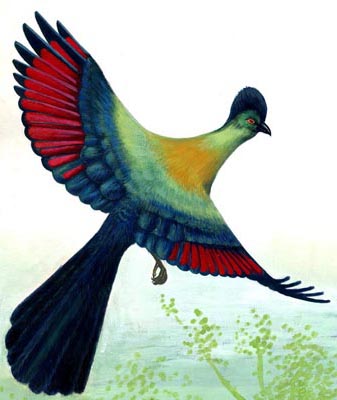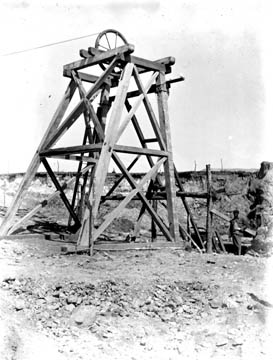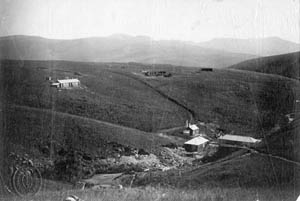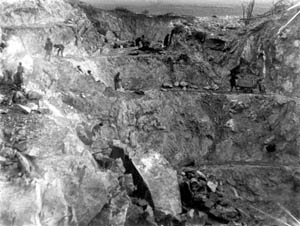The ENTC now has a new website, at www.entc.org.sz
Our logo is adapted from a painting by Phillip Dlamini, 1998, of a purple crested turaco. In traditional Swazi dress, the red feathers feature in the royal headdress, so this bird illustration is not only a symbol for wildlife conservation, but also of cultural heritage.


Adapted from Bulletin No 9 of the Geological Survey and Mines Department, Photos: Swaziland Digital Archives.

It is not possible to say when or who first discovered gold in Swaziland. Pre-European gold mining was known to have occurred in Swaziland, however these ancient excavations were destroyed in the colonial era when the same gold reefs were mined. In recent times gold was recorded in about 1872, although initial attempts to exploit the metal only date from 1880. The first mine to be discovered was Forbes Main Reef which is located on the edge of Malolotja and can easily be visited. The exact year of discovery is disputed but it was either in 1883 or 1884. Some 30 other reefs were found within a 5 km radius, 10 were rich enough to reach the status of mines. Mining was carried out at other localities outside the reserve, notably in the Piggs Peak area.
Gold production was always sporadic and prior to the Boer War only mines in the Forbes Reef area attained consistent production. This first phase of the mines ended in 1897.

After the Boer War until the outbreak of the 1914-18 war gold continued to be extracted on a small scale. From 1920 to 1960 irregular and smaller production was recorded, until finally in the period 1960 to 67 only the She, Waterfall and Lomati Extension mines reported production. After this date none of the mines situated in the reserve operated. The most recent production of gold occurred from Red Reefs, just outside Malolotja, in 1976 to 77, although some new exploration occurred in the 1990's.
Nearly 55% of the total gold output for the Kingdom was recorded between 1908 and 1919. Earlier records are scarce but it is assumed that a similar amount of gold was mined in that period, the total production figure for the kingdom is estimated at 250 000 ounces. (For comparison in 1973 South Africa produced over 25 000 000 ounces.)
Many gold bearing reefs were not exploited because they were too small or produced ore which was too low grade, although the perilous financial situation of the companies which held the rights was also a contributing factor to this lack of exploitation.
Within Malolotja Nature Reserve's borders there are two main mining areas, the Forbes Reef Series and the Avalanche Series.

About the end of the 1870's, four Europeans all possessing knowledge of mines and minerals came to Swaziland, they were attracted by old traders' stories of hidden riches. It was the time of the concession years of King Mbandzeni. Messrs David and James Forbes, Tom McLachlan and Walter Carter were welcomed and well treated by the Swazi king. James Forbes obtained the concession to the Forbes Reef area, now inside Malolotja Nature Reserve, while McLachlan and Carter selected the area that is now Piggs Peak and Horo.
Forbes Main Reef was the second most productive mine in Swaziland and the most productive in Malolotja. It was discovered by Alec Forbes and Charles Swears, probably in November 1883 but possibly in 1884. It declared production in 1886 of about 100 ounces per week, but a few years later the property was turning out 2 000 ounces of gold per month and Forbes Reef shares stood at 5 pounds sterling per share in the market. The profits were spent in buying machinery. Unfortunately the nearest railway line was the Biggersberg in Natal, which meant huge distances had to be covered by ox wagon at very expensive rates. At current values a ton carried by ox wagon from the Biggersburg would cost approximately E8000.

The deepest tunnels in the mine were 375 feet. The water for gold mining was obtained from the Forbes Reef dam, which is still there today and is now used for trout fishing. Sadly the old buildings, which included workshops for carpentry, a saw mill, an assay lab, amalgamation house and engineers shop, equipped with 18ft lathe have all disappeared. The stone fort-like building which was erected and equipped with an armoury of guns and ammunition to deter Boer attacks has also disappeared.
The years 1886 to 88 were the boom years for the mine. After this the mine struggled to remain profitable, the company was refloated several times. On December 6th 1894, the timbering down the shaft gave way trapping the night shift underground. Fortunately the men were rescued without injury.
The concession suffered considerable damage during the Boer War and in October 1902, Forbes Reef Gold Mining Company became part of the Swaziland Corporation Ltd. The first inspection by the Commission took place in 1904/5. Thomas Andrews took up most of the options and from 1907 to 1911 various sons of his managed the mines, so that he ran a minor mining empire.
In late January 1909 a great storm, probably a cyclone, occurred. Its effects were far reaching. Forbes Reef Mine was flooded, the power station and parts of the mill were washed away and the collar and headgear of the vertical shaft collapsed.
In 1911, the agreement with Andrews was cancelled for some reason that is unclear, although possibly the corporation, seeing that the mine could be worked at a profit, decided to work it themselves. Accordingly in 1911 some of the smaller mines were worked, but after 1913, capital was not forthcoming and all work ceased.
In 1932 the Swaziland Corporation allowed the rights of Forbes Reef to lapse and the area was opened to public prospecting. This brought about a minor gold rush with over 160 people lining up to wait for the starter's gun. The area was pegged and in 1934 a company, the Golden Goose, was formed which treated the tailings using a small cyanide plant. After 1935 no mining occurred there. The total recorded production for Main Reef, from 1884 to 1935, was 31 037.57 ounces.
Forbes Main Reef is easily visited and the adits may be explored. However, the area is full of small pits and deep shafts and can be dangerous. It is extremely important to keep to the path and to take great care when visiting the mine.
None of the other reefs and mines of the Forbes Reef area were very productive. The Waterfall Mine site was first noted in 1889, but no development took place. It was rediscovered in 1953 and the She syndicate obtained the prospecting title in 1956. Production started under license to E Wiseman in March 1962, but the original quartz vein was soon mined out. In all, during the years 1962 to 66, 4707.97 ounces of gold was mined. Welcome began to be worked in 1887 and values of 4cwt/ton were recorded. Evelyn was known prior to 1888 but no information survived. For Kenilworth, the only information is that an adit was driven, and Masons is represented by a pit 3m x 3m x 2m excavation in marshy ground next to an access road. Reefs No 18 and 20 had trenches excavated at some unknown time. At Allen Waters, there is no trace of mining.
| Mine Production | (oz) |
| Main Reef | 31 037.57 |
| Waterfall | 4 707.97 |
| Total (oz) | 35 745.54 |
These mines and gold bearing reefs are part of a series ranging from the She East reef in the north to the reefs south of the Art Union Extension. There are over twenty-five areas or mines where gold was extracted in the reserve.
Avalanche mine is the second most productive body in the area. The surface reef was discovered by W Elkington in1887, the mine has had a very chequered history. Milling began at Avalanche in 1894 although the collapse of the main shaft the same year halted production. The Commission's inspection of 1904 and 1905 of virtually all the known gold reefs concluded that Avalanche, along with Main Reef, were localities where work should be concentrated. In 1907, the mine was signed over to Thomas Andrews, who put his son Ernest in charge of operations. The terrible storm of 1909 had drastic consequences for the mine when the collapse of the quarry stopped development.
Between the years 1888 to 1910, 11 188.10 ounces of gold were recorded from Avalanche.
None of the other small mines in this area produced much gold, although several were worked until the 1960's.
In 1911, Allister Miller began a programme of surface and underground prospecting around Ivanhoe mine, but capital ran out and work stopped in 1913. Windermere (renamed Rosehill and later Thompsons) was also worked a little, firstly by Andrews and later in the 1930's. The scars from both these mines can still clearly be seen on the hills due west of the main tourist office. Records also exist for sporadic mining at Hazelmere, Waverley, Art Union, Primrose, Oban, Rajah and She Mine which was the last to be worked within Malolotja. It is possible to visit the She Mine surface trenches, however it is very unstable and must not be entered. In 1960 E Wiseman obtained a mining permit and he worked it under the company name of RhoSwazi until 1966. No records exist of any gold production from She East, Jim's Luck, No 32, Buckingham, Jasper, Iron or Gumtree.
| Mine | (oz) | Grade cwt/ton |
| Rajah | 61.94 | ? |
| Hazelmere | 34.18 | 11.0 |
| She | 4 767.98 | 2.9 |
| Oban | 45.50 | 13.0 |
| Waverley | 928.82 | 2.08 |
| Ivanhoe | 59.75 | 11.38 |
| Avalanche | 11 188.10 | 2.5 |
| Windermere | 465.59 | ? |
| Primrose | 50.40 | 16.0 |
| Art Union | 314.43 | 11.5 |
| Art Union Extension | 18.97 | ? |
| Total | 17 935.65 |
Our Contacts:
Head Quarters: (+268) 2416 1489/1179
Email: info@sntc.org.sz
King Sobhuza II Park: (+268) 2416 1489/1179
Email: ksmp@sntc.org.sz
National Museum: (+268) 2416 1489/1179
Email: curator@sntc.org.sz
Copyright © ESWATINI NATIONAL TRUST COMMISSION
Malolotja Nature Reserve: (+268) 2444 3241 / (+268) 2416 1480
Email: culturalvillage@sntc.org.sz
Mantenga Nature Reserve and Swati Cultural Village: 2416 1151/1178
Email: culturalvillage@sntc.org.sz
Mlawula Nature Reserve: (+268) 2383 8885 (Reception)
(+268) 2383 8453 (Senior Warden)
Email: culturalvillage@sntc.org.sz
Magadzavane Lodge: (+268) 2343 5108/9
Email: magadzavane@sntc.org.sz